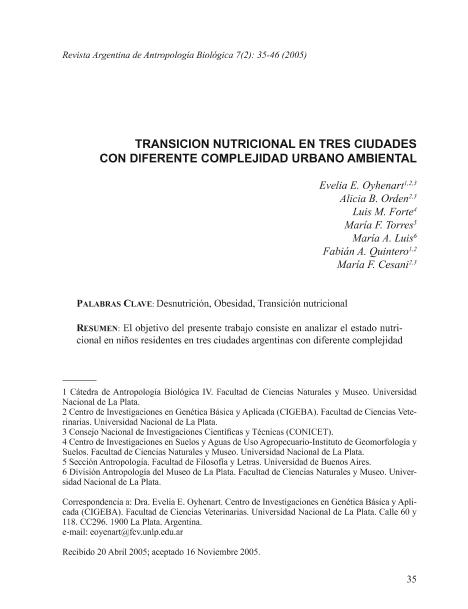Artículo
El objetivo del presente trabajo consiste en analizar el estado nutricional en niños residentes en tres ciudades argentinas con diferente complejidad urbano ambiental, en el contexto de la transición nutricional. Se realizó un estudio antropométrico transversal sobre una muestra de 5190 niños de ambos sexos de 4.0 a 14.9 años que asisten a escuelas públicas de las ciudades de La Plata y Brandsen (Provincia de Buenos Aires) y General Alvear (Provincia de Mendoza). Se relevaron peso corporal y talla y se calculó el índice de masa corporal (IMC). Los datos fueron estandarizados a puntaje z empleando NHANES I y II. Se utilizó -2DS para determinar bajo peso para la edad, baja talla para la edad y bajo peso para la talla. Los valores de IMC mayores al percentilo 85 y menores o iguales al percentilo 95 definieron sobrepeso, mientras que los mayores al percentilo 95 obesidad. Las prevalencias para cada indicador fueron comparadas mediante pruebas de Chi2 . El procesamiento de los datos se realizó mediante el programa SPSS 7.0. Los resultados obtenidos confirman lo hallado en otras poblaciones latinoamericanas, caracterizadas por un predominio de retraso lineal de crecimiento y bajos niveles de emaciación. Las tres ciudades presentaron coexistencia de desnutrición y obesidad. No obstante, las diferencias halladas sugieren distintos estadios de transición nutricional: La Plata y Brandsen se ubicarían en un estadio más avanzado, con altas prevalencias de desnutrición y obesidad, mientras que General Alvear reflejaría un estadio menos avanzado de dicha transición. The aim of the present study is to assess the nutritional status of children from three Argentinian cities with different urban-environmental complexity, in the context of nutrition transition. A cross-sectional study was carried out on 5190 schoolchildren of both sexes aged 4.0-14.9 years old, who attend to public schools of La Plata and Brandsen (Province of Buenos Aires) and General Alvear (Province of Mendoza). Weight and height were measured and body mass index (BMI), calculated. Data were standardized to z- score deviations from the 50th centile of the NHANES I and II reference. A z-score of less than –2 DS was used as the cut-off point to determine the prevalences of low weight-for-age, low height-for-age and low weight-for-height. IMC values equal or higher than 85th centile and lower than 95th centile were employed to assess overweight. Obesity was defined by IMC values higher than 95th centile. Comparisons between prevalences were performed by means of Chi2 analysis. Data were processed by SPSS 7.0 program. The results agree with those found in other Latin American populations characterized by high levels of stunting and low levels of wasting. All the cities presented the coexistence of undernutrition and obesity. Nevertheless, the differences suggest variable stages of nutrition transition: La Plata and Brandsen would exhibit a more advanced stage, with high prevalences of undernutrition and obesity, while General Alvear would reflect the least advanced stage of such transition.
Transición nutricional en tres ciudades con diferente complejidad urbano ambiental
Oyhenart, Evelia Edith ; Orden, Alicia Bibiana
; Orden, Alicia Bibiana ; Forte, Luis María; Torres, María Fernanda
; Forte, Luis María; Torres, María Fernanda ; Luis, María Antonia; Quintero, Fabian Anibal; Cesani Rossi, María Florencia
; Luis, María Antonia; Quintero, Fabian Anibal; Cesani Rossi, María Florencia
 ; Orden, Alicia Bibiana
; Orden, Alicia Bibiana ; Forte, Luis María; Torres, María Fernanda
; Forte, Luis María; Torres, María Fernanda ; Luis, María Antonia; Quintero, Fabian Anibal; Cesani Rossi, María Florencia
; Luis, María Antonia; Quintero, Fabian Anibal; Cesani Rossi, María Florencia
Fecha de publicación:
10/2005
Editorial:
Sociedad Argentina de Antropología Biológica
Revista:
Revista Argentina de Antropología Biológica
ISSN:
1514-7991
e-ISSN:
1853-6387
Idioma:
Español
Tipo de recurso:
Artículo publicado
Clasificación temática:
Resumen
Palabras clave:
Desnutrición
,
Obesidad
,
Transición Nutricional
Archivos asociados
Licencia
Identificadores
Colecciones
Articulos(CCT - LA PLATA)
Articulos de CTRO.CIENTIFICO TECNOL.CONICET - LA PLATA
Articulos de CTRO.CIENTIFICO TECNOL.CONICET - LA PLATA
Articulos(IGEVET)
Articulos de INST.DE GENETICA VET ING FERNANDO NOEL DULOUT
Articulos de INST.DE GENETICA VET ING FERNANDO NOEL DULOUT
Citación
Oyhenart, Evelia Edith; Orden, Alicia Bibiana; Forte, Luis María; Torres, María Fernanda; Luis, María Antonia; et al.; Transición nutricional en tres ciudades con diferente complejidad urbano ambiental; Sociedad Argentina de Antropología Biológica; Revista Argentina de Antropología Biológica; 7; 2; 10-2005; 35-46
Compartir



